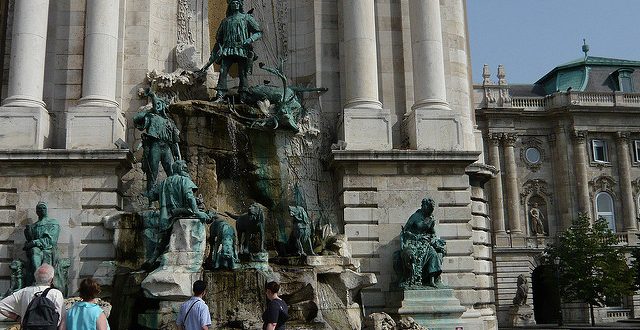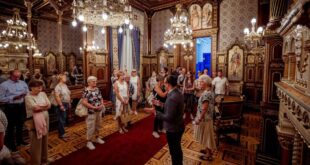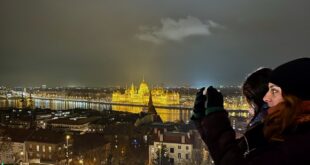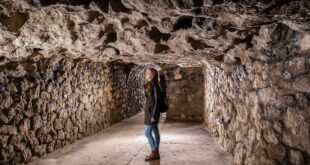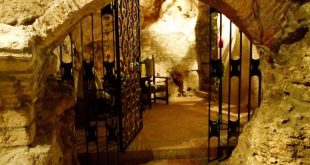Matthias Fountain is one of the most beautiful sculptures and fountains in Budapest. The Fountain is in the Buda Castle on the Hunyadi Court, featuring King Matthias in a royal hunting scene with a hidden love story.
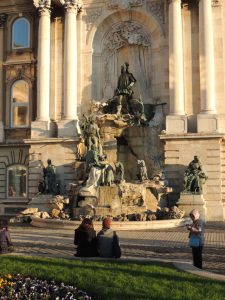
The story of Matthias Fountain, this amazingly ornate, beautifully crafted sculpture, is a sad, poignant love story, symbolising the human heart’s never ending hunt for happiness.
According to the legend, King Matthias Hunyadi, the fairest king of Hungary, went hunting in disguise. He was often disguised to see the true affairs of the Hungarian Kingdom. During the hunting, he met a pretty peasant girl called Beautiful Little Helen (Szep Ilonka in Hungarian). They fell in love at first sight, but when she found out that he was the king of Hungary, she realised that their love could never come complete, and consummated in a marriage, so she died from a broken heart.
The more you look at Matthias Fountain, the more details become apparent.
In the Fountain, you can see Szep Ilonka – on the right side of the Fountain – gently caressing a fragile young deer, watching the hunters in awe. King Matthias is the top figure, the young ruler is triumphantly standing with his deadly bow and arrow on the huge rock by the spring where he shot the stag, looking over his kingdom in full victory. His three dogs came to quench their thirst with fresh spring water, but just like the dogs, his huntsmen aids are on the alert, one of them ready to blow his hunting horn. The calm sitting figure on the left makes the Fountain symmetrical, he is the royal historian, free from fear, impartially writing the story of King Matthias, just as the sculptor was paying tribute to the king and his deeds.
History of Matthias Fountain
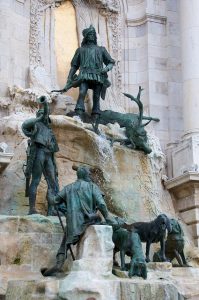
This monumental fountain group is a Neo-Baroque work by Alajos Strobl and Alajos Hauszmann from the very beginning of the twentieth century.
Matthias Fountain was designed in 1904, and built against the wall of the central wing of the Buda Castle.
The statue is a perfect artwork of its time, and the aristocratic tastes of the 1900s period. But it is also a challenging statement of Hungarian noble men, having a longing for their own independent kingdom in the Habsburg led Austro-Hungarian Empire, right in the Buda Castle, the residence of Austrian Habsburg kings.
Matthias Fountain shows a royal hunting scene with the bronze figure of King Matthias holding a crossbow in his hand, standing near a beautiful dead deer. At his feet there are three large hunting dogs, Hungarian vizsla dogs, his gamekeeper and his shield bearer, both holding the hunting horns.
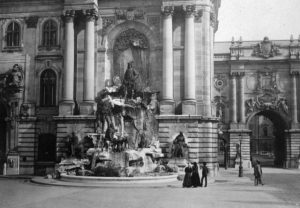
To the left is the seated figure of Galeotto Marzio, the Italian court historian of King Matthias, a true Renaissance king who favoured history, culture, architecture and diversity. Galeotto Marzio was the first who recorded the story of Beautiful Helen (Szep Ilonka), later on elevated into top notch poetry by Mihaly Vorosmarty the celebrated national poet of the 19th century. The historian holds a falcon on his wrist. On the other side of the Matthias Fountain, you can see Szep Ilonka herself, who appears to be feeding a young deer.
Alajos Strobl the sculptor felt a true inner need to have this statue in the Buda Castle. So much so that he hardly got any payment for the statue, but he was lowering his needs just to make sure that the statue will be presented in the Buda Castle. Strobl managed to convince Alajos Hauszmann to our greatest pleasure.
Interestingly, the Fountain survived the destruction of the World War II with only minor damage (the dog in the middle was destroyed).
Matthias Fountain has recently been restored in 2010 to its full beauty.
The arrangement of the figures bears resemblance to the famous Trevi Fountain in Rome, therefore, supposedly, if anyone throws coins in the fountain will be back to Budapest.
Address: Hunyadi Courtyard of Buda Castle, Budapest District I
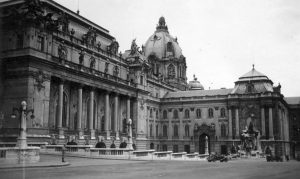
Getting there
Bus: 16A from Szell Kalman ter or 16 from Deak ter.
Funicular: From Clark Adam ter to Castle Hill
On Foot: 10 min walk from Matthias Church, and the Fisherman’s Bastion in the Buda Castle District.
 Buda Castle Buda Castle, Budapest
Buda Castle Buda Castle, Budapest
